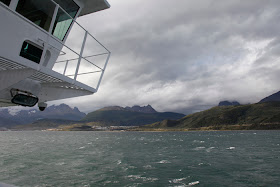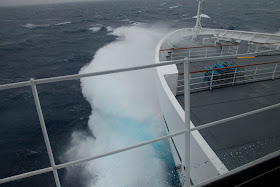During the night we made good speed and in the morning we were in the eastern part of the Bransfield Strait. The sea has calmed down considerably and we enjoyed an agreeable sea day with good weather, a little bit overcast. The sunshine gave us a good view on the western coast of the Antarctic Peninsula with high snow covered mountains and glaciers coming down into the sea. During the morning and also in the early afternoon we had lectures about the Nordenskjöld expedition, seals, penguins, ice and geology.
Around noon we reached the entrance of the Antarctic Sound, more and bigger icebergs especially tabular icebergs appeared and the wind became stronger and the waves higher.

Around 15.00 we arrived at the Argentinean Station Esperanza, we contact its crew and they told us, that there is no possibility for a landing under the prevailing condition. Our Expedition leader decided to wait until the weather conditions would have improved and went further into the Antarctic Sound to enjoy more of this marvellous scenery. We came close to Brown Bluff and checked the condition for a landing here, but the swell was too high for a safe operation with our Polar Circle Boats. Though the wind was blowing and we had quite high swell, we still had nice sunshine and could enjoy a the wonderful scenery of the Fridtjof Sound and the western part of the Weddell Sea with the high brown cliffs of the volcanic coast and the volcanic islands, glaciers, some small waterfalls and again lots of picturesque icebergs.

Turning back we passed again the Esperanza Station and again the swell was too high for a landing operation. We continued slowly through the Antarctic Sound, still cruising. Finally we made our way into the Bransfield Strait and sailed for our next exciting destination, the active volcano Deception Island.



















































